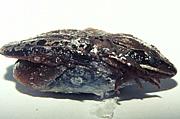 Frogsicle: wood frogs survive the freezing of more than half of their body water during hibernation.© Evelyn Dietz/ Laboratory for Ecophysiological Cryobiology
Frogsicle: wood frogs survive the freezing of more than half of their body water during hibernation.© Evelyn Dietz/ Laboratory for Ecophysiological CryobiologyNot being able to have a proper pee for months at a time might not sound like fun. But the build up of urea in frogs seems to help them survive freezing, desiccation and starvation during winter, says one study on a hardy northern amphibian.
The wood frog Rana sylvatica lives as far north as the Arctic Circle, and survives the freezing of more than half of its body water during hibernation.
As winter approaches, urea levels in these frogs climb drastically, report Jon Costanzo and Richard Lee, researchers at Miami University in Oxford, Ohio. During hibernation, the frogs barely urinate and urea is reabsorbed into their system, peaking at levels 50 times those seen in summer.
The body normally eliminates urea, through peeing, because it can be dangerous if it builds up: it can rip up cellular components at high concentrations.
"Urea has kind of a bad rap," says Costanzo. But the levels in the frog do not seem to be high enough to mangle the animal. Instead, this waste product becomes a balm.
Cold calculations
To show that urea protects frogs from the cold, the researchers subjected frog blood and tissues to a freeze-thaw cycle in a solution of urea. At concentrations found in hibernating frogs, urea protected the cells and tissues from damage.
Urea worked about as well as glucose, the only other molecule known to protect wood frogs from cold, says Costanzo. The findings appear in The Journal of Experimental Biology1.
Like other substances that protect from cold, urea is a small molecule that can cross the cell membrane. But exactly how it operates is unknown.
Previous work on desert frogs had shown that urea helps the animals retain water during dry conditions. And the winter spike in urea probably protects wood frogs from drying out in the snow and ice, says Costanzo.
Slow and steady
Costanzo and Lee's work also hints that urea might help to slow metabolism in a safe way. Using a dye that measures energy consumption, the researchers found that urea seems to slow down the liver and muscle tissue, but leaves the all-important kidney and heart alone.
ADVERTISEMENT
Slowing one's metabolism conserves energy, and wood frogs have a special interest in doing that during these sleepy months. The first thing that these frogs do in the spring thaw is mate; even before they eat and have a chance to replenish energy stocks.
Jack Layne, who studies cold hardiness at Slippery Rock University in Pennsylvania, says that finding that wood frogs can increase their urea concentrations is not in itself surprising, because desert frogs are known to do it.
But it is intriguing, Layne adds, to think that frogs might use this strategy to cope with cold. "You could argue that the build-up of urea is a forerunner adaptation that set the stage for freeze tolerance to evolve."
-
References
- CostanzoJ. P., LeeR. E. The Journal of Experimental Biology, 208. 4079 - 4089 (2005). | PubMed |
